7 Miscellaneous Dark-spored Gilled Mushrooms
All gilled mushrooms with deeply colored spores are grouped here with the exception of Agaricus. The spore color ranges from rusty-orange to brown, rusty-brown, purple-gray, or black. A veil may or may not be present. In those with a veil, either the gills are attached to the stalk or the spores are differently colored than those of Agaricus.
There are more than 1000 western mushrooms in this category. A few are sought for their edible or hallucinogenic properties, but most are poisonous or of unknown edibility. See MD 341–487 for a more comprehensive treatment.
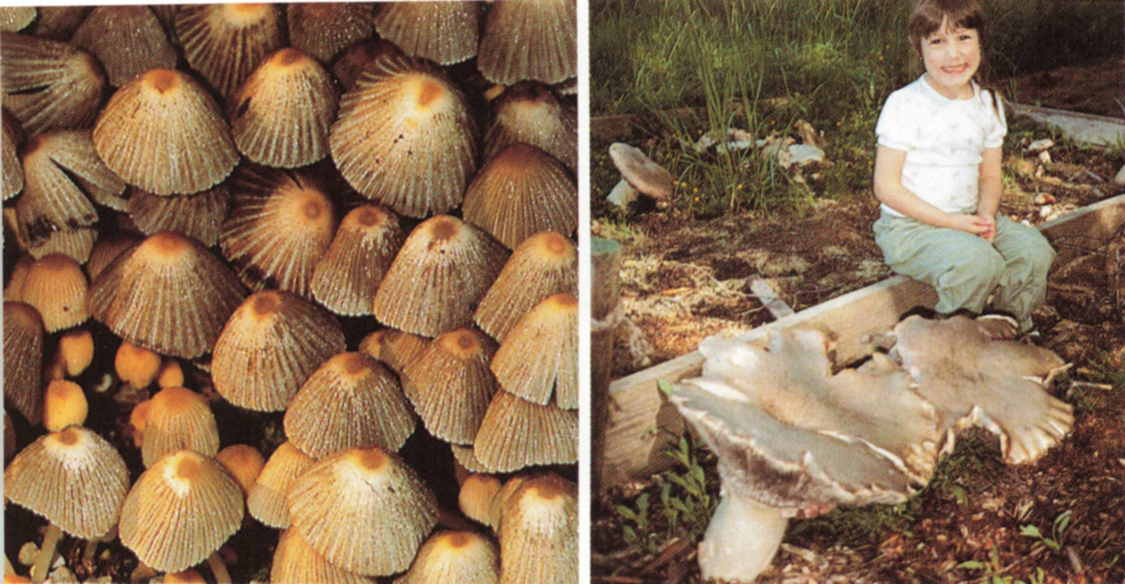
The big and small of it: each Coprinus disseminatus (see MD 352) averages ¼″ broad; king stropharias (this page) can weigh several pounds.
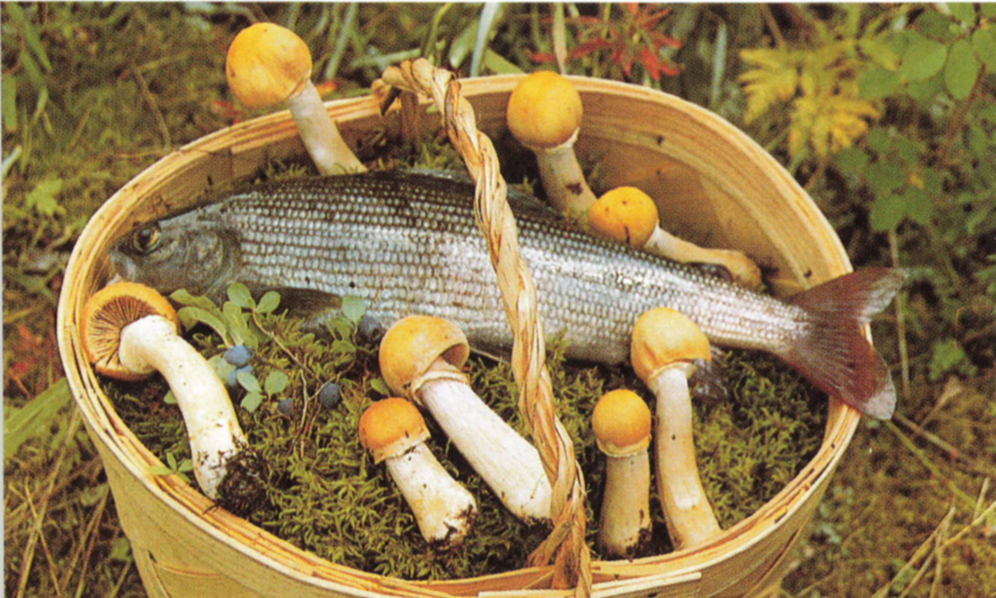
King Stropharia (Stropharia rugoso-annulata)

Other Names: Wine-red Stropharia, Giant Garden Stropharia.
Key Features:
1. Cap wine-red to red-brown when young (but often fading to tan as it ages).
2. Surface of cap sticky or slimy when moist, bald.
3. Gills attached to stalk, at first gray or purple-gray, becoming black in old age.
4. Stalk at least ½″ thick, white when fresh.
5. Veil present, at first covering the gills, then forming a prominent ring on stalk.
6. Ring grooved or ridged on upper surface.
7. Spores deeply colored (dark purple-brown to black).
Other Features: Medium-sized to very large; flesh white, not discoloring appreciably when bruised; ring often segmented or clawlike; white threads often emanating from base of stalk; volva absent.
Where: In humus, wood chips, straw, grass, gardens, landscaped areas, etc., often in groups; fairly common in the Pacific Northwest. As it is grown at home by more and more people, its range will surely spread.
Edibility: Very good: cook it as you would the regular commercial mushroom.
Note: This handsome mushroom has become very popular with home growers because it is easy to cultivate, attains prodigious size (see photo on this page), fruits prolifically, and is tasty besides! See MD 378–379 for more information.
Questionable Stropharia (Stropharia ambigua)

Key Features:
1. Cap buff to yellow or yellow-brown.
2. Surface of cap sticky or slimy when moist, bald.
3. Edge of cap adorned with cottony white veil tissue.
4. Mature gills gray to purple-gray or black, usually attached to stalk.
5. Stalk with a shaggy coating of soft white scales.
6. Veil present, at first covering gills, then shredding into many pieces that dangle from edge of cap, and sometimes also forming a slight ring on stalk.
7. Spores deeply colored (dark purple-brown to black).
Other Features: Medium-sized, usually tall and slender; cap domed at first, flat in age; gills occasionally pulling away from stalk in age; white threads often emanating from base; volva absent.
Where: On ground, rich soil, or wood chips in forests and at their edges; common on West Coast. It favors cold, damp situations.
Edibility: Not recommended.
Note: This is an elegant mushroom in its prime. The bald, sticky or slimy cap and attached gills distinguish it from Agaricus, while Amanita has much paler gills. S. hornemanni is a similar woodland species with a yellow-brown, red-brown, or gray-purple cap and well-developed ring on the stalk. See MD 377–380 and plate 89.
Dung Dome (Stropharia semiglobata)
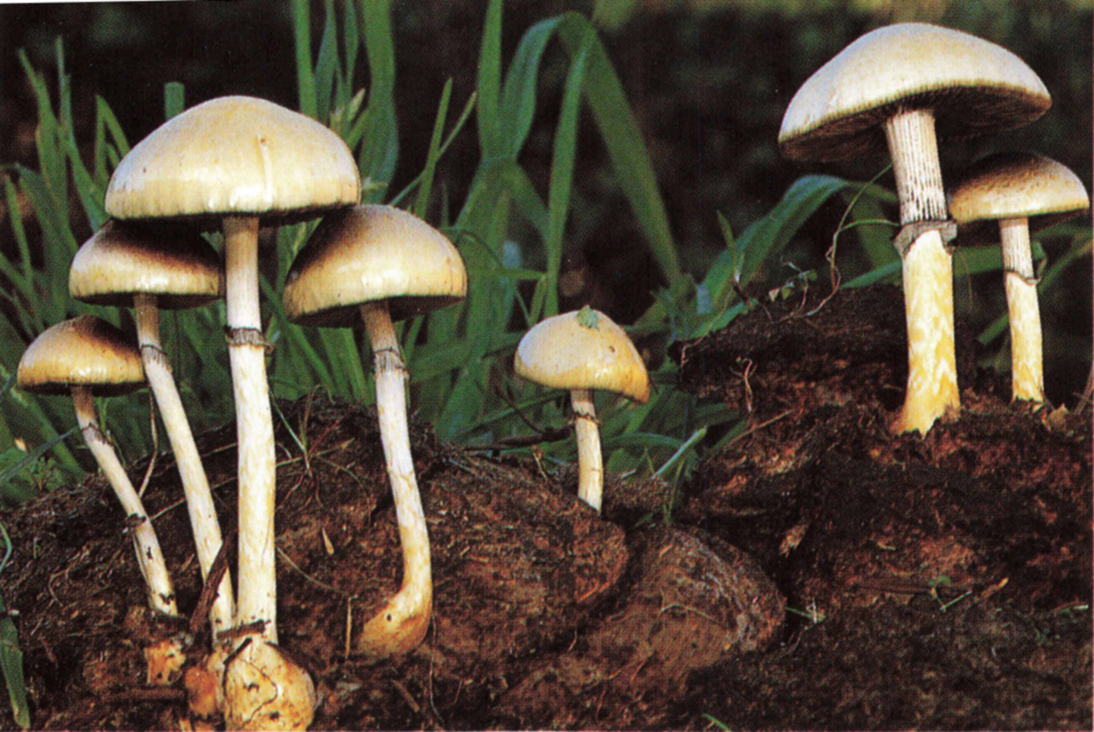
Other Names: Hemispherical Stropharia, Round Stropharia.
Key Features:
1. Cap small (<2″ broad and usually ±1″), domed when young and slightly domed even when mature.
2. Cap yellow, blond, or straw-colored, the surface bald and sticky or slimy when moist.
3. Gills gray to black when mature, attached to stalk.
4. Stalk slender, without scales, at least the lower half sticky or slimy when moist.
5. Veil present in young specimens.
6. Cap, stalk, and flesh not blueing when handled.
7. Spores deeply colored (dark purple-brown to black).
8. Growing on or near dung.
Other Features: Stalk long in relation to width; veil thin, disappearing with age or forming a small ring that is subsequently blackened by spores; ring, if present, not grooved or ridged on upper surface; volva absent.
Where: Alone or in groups in dung, manure, compost, and fertilized grass; widespread and common.
Edibility: Not recommended.
Note: This is one of our most common dung mushrooms, often found with the dung bell. It resembles Psilocybe cubensis, the famous “magic mushroom” of the tropics, but does not stain blue when handled. There are several similar dung-lovers, including species of Agrocybe, which have brown spores. See MD 376 for more information.
Dung Bell (Panaeolus campanulatus)

Other Names: Bell-shaped Panaeolus, Panaeolus sphinctrinus.
Key Features:
1. Cap cone-shaped or bell-shaped, small and fragile.
2. Cap gray to brown or olive-brown.
3. Surface of cap not sticky or slimy and not netted or ridged.
4. Edge of cap adorned with small white toothlike veil remnants, at least when young.
5. Gills gray to black (never brown), their faces mottled with darker and lighter areas.
6. Stalk very thin (<⅛″) and brittle, gray or brown (not white).
7. Growing on or near dung.
Other Features: Cap bald or breaking up to form a few scales; veil present, covering gills when very young but not normally forming a ring on stalk; stalk often long; volva absent; spores black.
Where: In or near dung, especially of cattle, often in small groups or colonies; widespread and very common.
Edibility: Not recommended.
Note: This dung-lover is sure to be found wherever cattle graze. If a chunk of dung laden with mushrooms is kept in a moist chamber, new ones will appear every day for several weeks — a veritable “dung garden.” There are several similar Panaeolus species. See MD 353–360 and plate 83.
Liberty Cap (Psilocybe semilanceata)

Key Features:
1. Cap tiny (<1″ broad), narrowly cone-shaped to bell-shaped, with a central knob or “peak.”
2. Cap brownish when fresh but fading to tan or buff as it loses moisture.
3. Surface of cap sticky when moist, the skin peeling cleanly from the flesh.
4. Mature gills dark gray to purple-brown.
5. Stalk very thin (<⅛″), whitish, without scales.
6. Ring and volva absent (veil, if present, soon disappearing).
7. Spores deeply colored (purple-brown or darker).
8. Growing in grass.
Other Features: Cap sometimes with bluish or olive stains; sides of gills not prominently mottled; stalk often curved; volva absent.
Where: In tall grass, meadows, and pastures but not in dung or on lawns; Pacific Northwest, common.
Edibility: Hallucinogenic; it contains psilocybin and psilocin and is often used as a recreational drug.
Note: This little mushroom has several look-alikes, but the above set of fieldmarks will distinguish it. Because it likes to hide in tall sedge grass, people scouring meadows for it are forced to adopt a characteristic “psilocybe stoop” (below) that is recognizable from afar. See MD 368–371.

Potent Psilocybe (Psilocybe cyanescens)
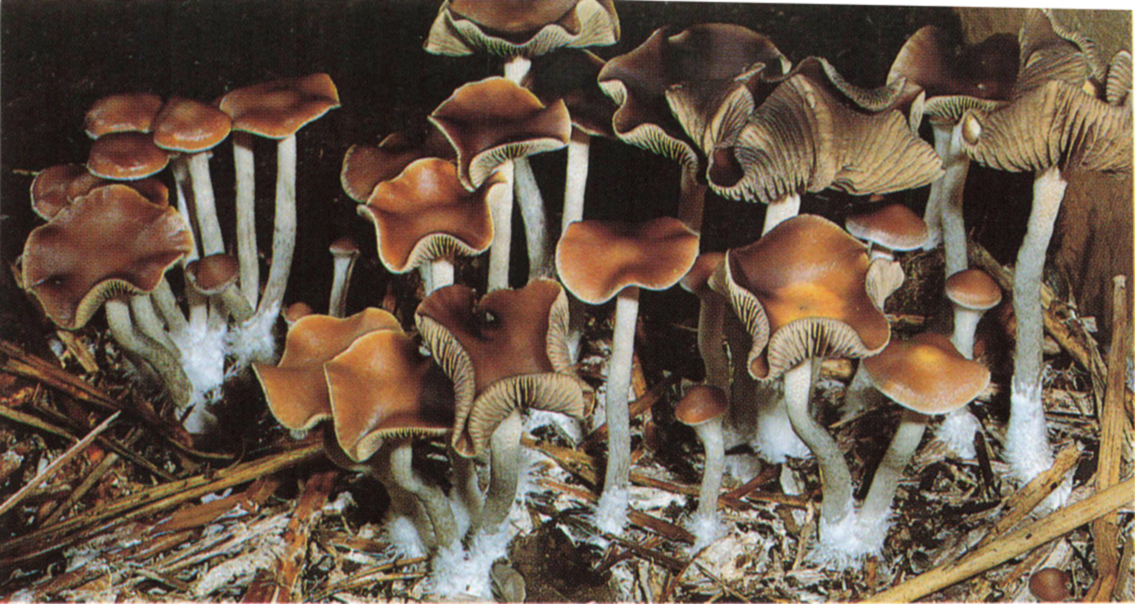
Other Names: Blueing Psilocybe, Magic Mushroom.
Key Features:
1. Cap domed (not sharply cone-shaped) when young, flat or often wavy at maturity.
2. Cap reddish-brown, dark brown, or caramel-brown (sometimes with bluish stains), fading to tan, dull yellow, or buff as it loses moisture.
3. Surface of cap bald, slightly sticky when moist.
4. Gills brown when young, darker in age.
5. Stalk slender, whitish when fresh but developing bluish or blue-green stains when handled or in age.
6. Veil present when young, composed of hairs or fine fibers, not forming an obvious ring on stalk.
7. Spores deeply colored (purple-gray to dark purple-brown), never dull brown, yellow-brown, or rusty-brown.
Other Features: Small to medium-small; gills typically attached to stalk; veil white, often leaving a few remnants on stalk or edge of cap; volva absent.
Where: In wood chips, landscaped areas, at the edges of woods, etc., usually in groups; common in the Pacific Northwest and northern California, and spreading.
Edibility: Strongly hallucinogenic. It contains high concentrations of psilocybin and psilocin.
Note: Like most “psilocybin mushrooms,” this one stains blue or greenish-blue, but beware: not all mushrooms that stain blue contain psilocybin! A smaller species, P. stuntzii, is common in the Puget Sound area; it has a small ring on the stalk. See MD 368–369, 371–373, and plate 88.
Inky Cap (Coprinus atramentarius)

Other Names: Alcohol Inky Cap, Common Inky Cap.
Key Features:
1. Cap 1–2″ high and broad, at first oval, then cone-shaped or bell-shaped.
2. Cap tan to grayish-brown when young, grayer with age.
3. Cap and gills digesting themselves from the bottom (edge of cap) upward as they mature, turning into an inky black fluid.
4. Gills crowded together, at first white, then turning gray before becoming black and inky.
5. Stalk white or mostly white, hollow.
Other Features: Fragile; cap bald or sometimes with a few silky white fibers or small scales, the edge striate (with fine radial lines or grooves) in age; gills free from stalk or nearly so; veil present when young, disappearing in age or forming a slight ring or small volva; spores black.
Where: Grouped or clustered on ground or rotten wood in many habitats (lawns, roadsides, gardens, old fields, hardwood and mixed forests, etc.); widespread and common.
Edibility: Not recommended. If eaten with, or even several days before, alcohol, it can produce transitory but alarming symptoms: rapid heartbeat, a flushed face, metallic taste, and puffiness or numbness in the hands and feet.
Note: In urban areas this mushroom is as common as the shaggy mane, but keeps a lower profile. It is also frequent in forests with aspen, cottonwood, and birch. There are several similar, usually smaller, species of Coprinus. See MD 347–350 for more information.
Shaggy Mane (Coprinus comatus)
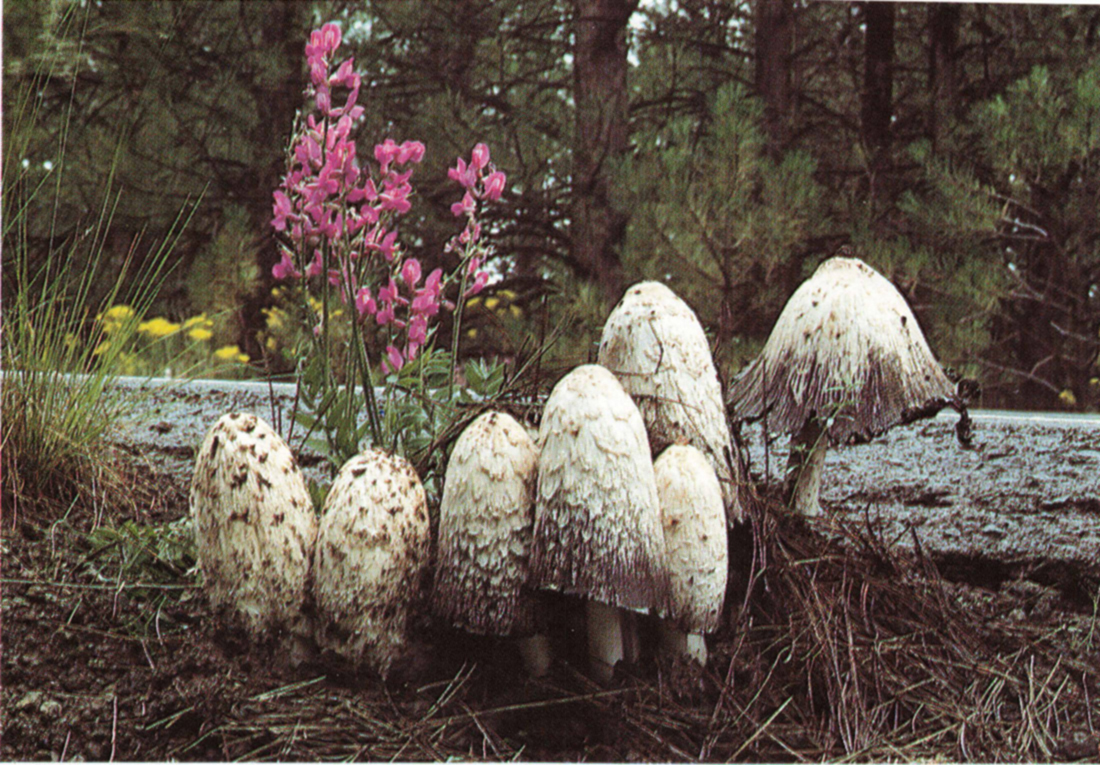
Other Names: Shaggie, Shag, Lawyer’s Wig.
Key Features:
1. Cap tall (2–10″ high) and cylindrical when young.
2. Cap shaggy, with brown scales (at least at center) on a white background.
3. Cap and gills digesting themselves from the bottom (edge of cap) upward as they mature, turning into an inky black fluid.
4. Stalk long, white, hollow.
5. Veil present when young, forming a small, often movable ring on lower stalk.
Other Features: Medium-sized to fairly large but fragile; cap becoming grayish and broadly bell-shaped as it liquefies; gills extremely crowded (like pages in a book), white at first, black in age, free from stalk; volva absent; spores black.
Where: Usually in groups or troops along roads and paths, around parking lots and compost heaps, on lawns, and in other areas where the ground has been disturbed; widespread and common. It is partial to cool or cold weather.
Edibility: Popular, but perishable and delicate. Pick only those that have not begun to liquefy and eat them as soon as possible. Also beware of those growing along busy roads, as they may be contaminated by exhaust fumes.
Note: Shaggy manes are the soldiers among mushrooms — hundreds can be seen “marching” in columns or ranks along country roads. They will even push up through asphalt — a remarkable feat for so fragile a fungus. See photos below; also, MD 345–346 and plate 85.

This clump of large, young “shags” is at the perfect stage for eating.

Some people write with “ink” from mature shags like this one.
Marinated Shaggy Manes
Slice them lengthwise, then sprinkle with a basic vinaigrette: three to four parts extra virgin olive oil to one part vinegar. For tasting pleasure I use a simple vinegar infused with wild mushrooms that are edible but not particularly used in fine cookery. For aroma I use vinegar infused for a week with sliced, dried puffballs. If the acid is mild, say lemon, perhaps a one-to-one ratio with oil might be better. Any wonderful, complementary, minced fresh herb may be strewn over the top of the shaggy manes before serving.
—Maya Spakowski
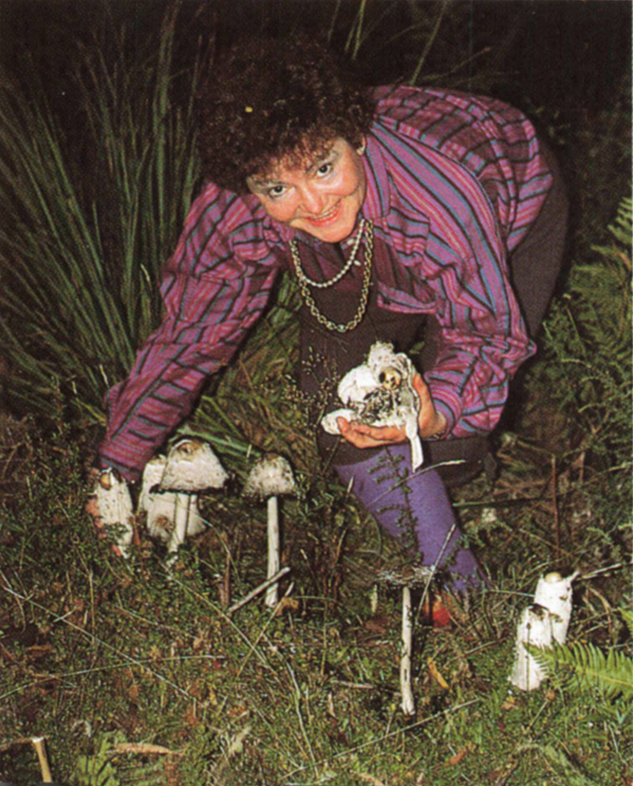
“Shaggy mania”: the tall white caps shine brightly in headlight beams, leading to impromptu nighttime harvests such as this one.

The delicate caps should be wiped clean or scraped gently with a knife, using as little water as possible.
Sulfur Tuft (Hypholoma fasciculare)

Other Names: Clustered Woodlover, Naematoloma fasciculare.
Key Features:
1. Cap yellow, orange-yellow, or greenish-yellow.
2. Surface of cap bald, not sticky or slimy.
3. Gills yellow to greenish-yellow when young, becoming gray to purple-black with age.
4. Stalk slender, yellow or tawny.
5. Spores deeply colored (purple-brown to deep purple-gray).
6. Growing in tufts or clusters on rotten wood.
Other Features: Small to medium-sized; cap domed when young, becoming flatter in age; transient veil present when young, sometimes leaving remnants on edge of cap or a very slight ring on stalk; volva absent; taste usually bitter.
Where: Tufted or clustered on logs, stumps, and wood chips; widespread and common on hardwoods as well as conifers.
Edibility: Poisonous.
Note: The yellow to chartreuse color of the young gills is the most distinctive feature of this common wood-rotter. A similar species, H. capnoides, has grayish gills when young, a mild taste, grows only on conifers, and is edible. See MD 382-384 and plate 92.
Deadly Galerina (Galerina autumnalis)

Other Names: Autumn Galerina.
Key Features:
1. Cap small (<2″ broad and usually ±1″), brown to tan or yellowish.
2. Surface of cap sticky when moist, bald.
3. Gills tan or brown.
4. Stalk slender (<¼), without scales.
5. Veil present, at first covering the gills, soon forming a small ring on upper stalk that may disappear with age.
6. Spores brown or rusty-brown.
7. Growing on wood.
Other Features: Edge of cap striate (with fine radial lines) when moist; stalk hollow, brown in age but paler when young; ring white at first, but often brown in age; volva absent.
Where: On rotten wood or wood chips (or sometimes on buried wood), alone or in small groups or tufts but not in big clusters; widespread and common but easily overlooked.
Edibility: Deadly poisonous! It contains the same toxins as the deadly amanitas (death cap and destroying angel), but is seldom eaten because of its small size.
Note: This little brown mushroom is sometimes mistaken for one of the hallucinogenic psilocybes, but can be distinguished by its brown spores. There are many related species of unknown edibility — a compelling reason to avoid all little brown mushrooms unless you are absolutely certain of their identity. See MD 32–33, 401, and 892–893 for more information.
Golden Pholiota (Pholiota aurivella)

Other Names: Lemon-yellow Pholiota.
Key Features:
1. Cap bright yellow to golden-orange with scattered brown to reddish-brown scales or patches.
2. Surface of cap slimy or sticky when moist, shiny when dry.
3. Gills yellow to brown or rusty-brown, attached to stalk.
4. Veil present, at first covering the gills, then disappearing or leaving hairy remnants on edge of cap and sometimes forming a slight ring on stalk.
5. Stalk pale yellow to yellow, with scales below the veil.
6. Spores brown.
7. Growing on wood.
Other Features: Medium-sized; scales on cap flat to slightly raised, but not erect; stalk surface dry or slightly sticky; volva absent.
Where: On logs and stumps, or on wounds of living trees, or sometimes wood chips, usually in groups or clusters; widespread and fairly common.
Edibility: Not recommended. In addition to being slimy, it sometimes causes digestive upsets.
Note: The above fieldmarks typify a confusing group of glutinous, golden pholiotas. Some members of the group (e.g., P. limonella) favor hardwoods; others (e.g., P. abietis) grow on conifers, and it is unclear how many are distinct species. See MD 390–391 and plate 95.
Scaly Pholiota (Pholiota squamosa)
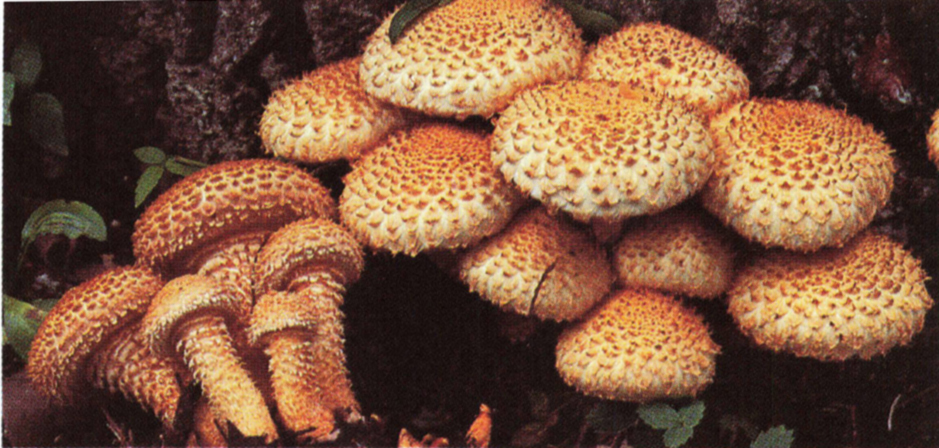
Other Names: Bristly Pholiota.
Key Features:
1. Cap and stalk covered with prominent erect or curled scales.
2. Scales on cap pale tan to brown, the background usually paler.
3. Surface of cap dry, not sticky or slimy.
4. Stalk at least ¼″ thick.
5. Odor often garlicky or onionlike (but see note below).
6. Spores brown.
7. Growing in clusters on wood or at the bases of trees.
Other Features: Medium-sized; gills at first yellowish, tan, or slightly greenish, becoming brown in age; veil present, at first covering the gills, then sometimes forming a fragile ring on stalk; volva absent.
Where: Clustered on hardwood stumps and logs or at the bases of trees (especially aspen), sometimes also on conifers; widespread in northern latitudes and at high elevations. It is plentiful wherever aspen occurs.
Edibility: Not recommended; some are made ill by it.
Note: This attractive, brown-spored aspen-lover is easily recognized by its blatantly scaly cap and stalk. It frequently has an onionlike or garlicky odor, but an unscented form also occurs. P. squarrosoides (MD plate 98) of the Pacific Northwest is very similar, but its cap is sticky or slimy beneath the scales. P. terrestris is also similar, but grows in clusters on the ground. See MD 389–390 and plate 97.

Jumbo Gym (Gymnopilus ventricosus)
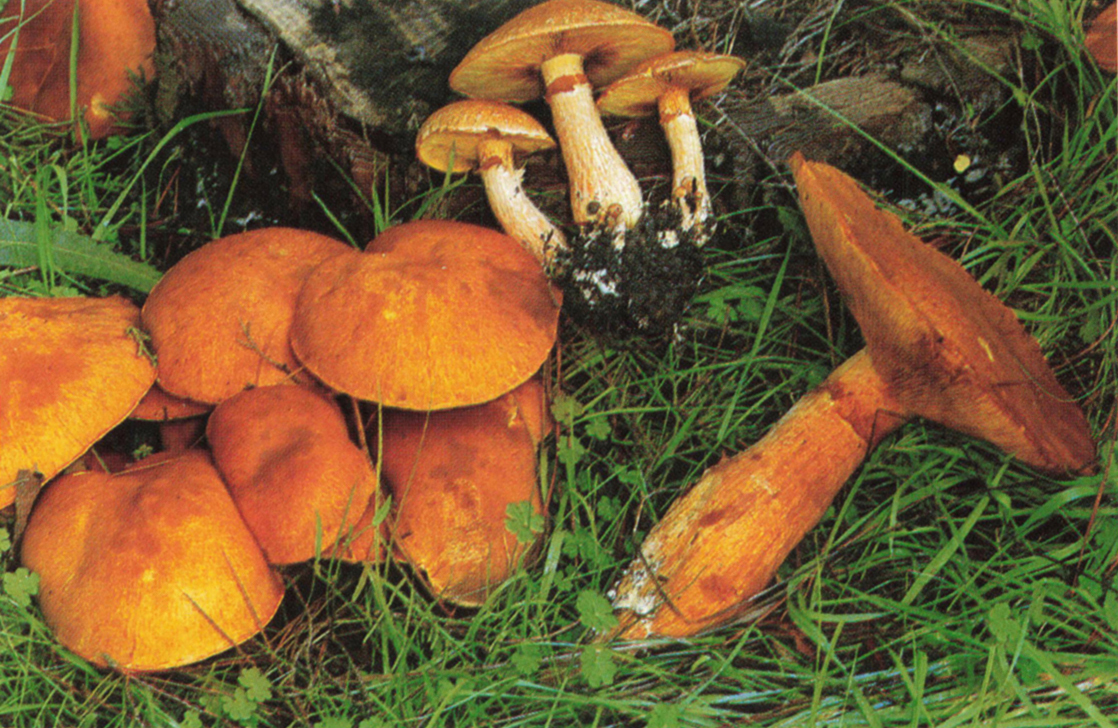
Other Names: Giant Gymnopilus, Big Laughing Mushroom, Gymnopilus spectabilis, G. junonius.
Key Features:
1. Medium-sized to very large (mature cap 3–20″ or more, stalk ½-4″ thick).
2. Cap and stalk yellowish to orange, not sticky or slimy.
3. Gills pale yellow when young, orangish or rusty-orange in age.
4. Stalk without scales.
5. Veil present, at first covering the gills, then often (but not always) forming a ring on stalk.
6. Taste bitter (chew on a piece of cap, then spit it out).
7. Spores orange to rusty-orange (spore dust often visible on ring or stalk).
8. Growing on dead wood.
Other Features: Cap bald or breaking up to form small scales; flesh thick, pale yellow; gills attached to stalk but running down it very little, if at all; stalk often thickest in middle or above base; volva absent.
Where: On logs, stumps, and buried wood (especially of pine), usually in clusters; widespread and common.
Edibility: Too bitter to eat; a close relative contains psilocybin and is hallucinogenic (see below).
Note: This mushroom is very similar to the big laughing mushroom (G. spectabilis) of Japan and eastern North America. However, it seems to lack the inebriating qualities of the big laughing mushroom, so “jumbo gym” is a better name for it. See MD 410–411 and plate 99 (as G. spectabilis).
Alaskan Gold (Phaeolepiota aurea)
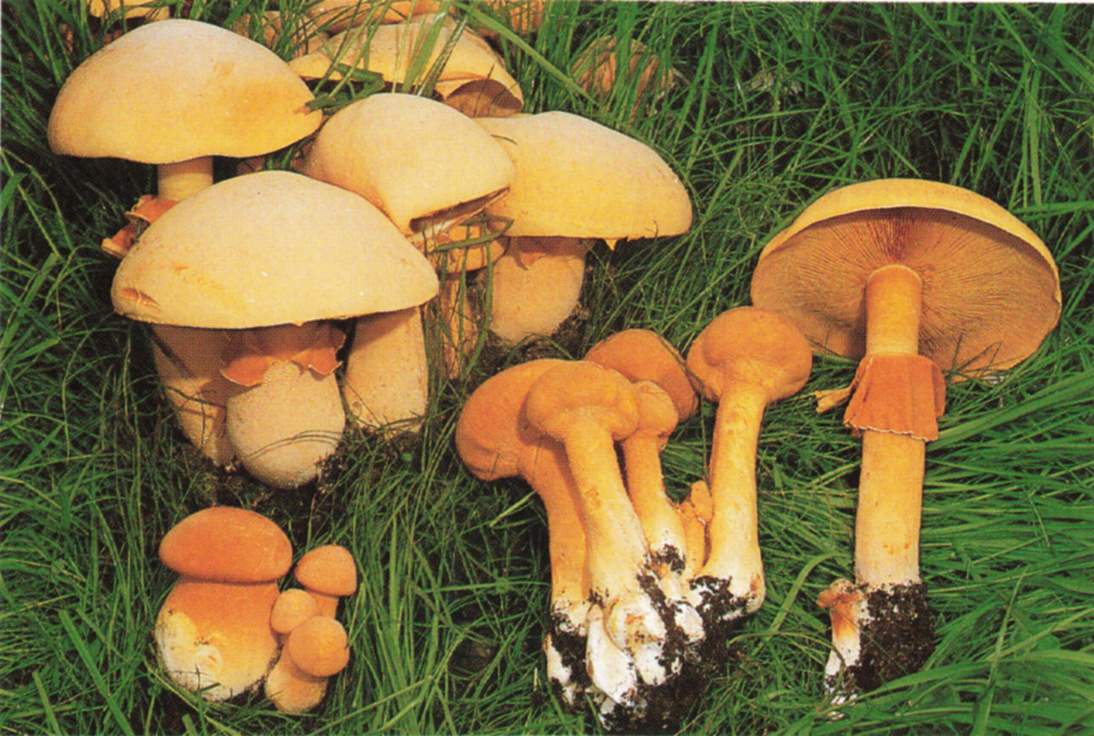
Other Names: Golden False Pholiota, Pholiota aurea, Togaria aurea.
Key Features:
1. Medium-sized to very large (cap 3–15″ broad, stalk at least ¾″ thick).
2. Cap and stalk golden-tan to golden-brown or orange-brown, covered with powder or flaky granules that are easily rubbed off (or washed off by rain).
3. Surface of cap and stalk dry, never sticky or slimy.
4. Gills yellowish to brown.
5. Veil present, at first funnel-shaped and covering the gills, then forming a large ring on stalk.
Other Features: Underside of ring also with granules; gills attached or free; volva absent; spores yellow-brown or ochre.
Where: In groups or large clumps on ground, usually at edges of woods or along roads and paths, especially near alder; Pacific Northwest and Rocky Mountains. Though infrequent to rare in most of its range, it is often abundant in Alaska.
Edibility: Prized by some people for its fine flavor, but poisonous to others, causing gastrointestinal distress. It should never be served to large groups of people.
Note: The large size, funnel-like veil, and granular garb make this one of the most impressive of all gilled mushrooms. Even when the granular coating is washed off the cap by rain it is usually evident on the stalk. The veil is never hairy or cobwebby as in Cortinarius. See MD 412–413 for more information.
Gypsy Mushroom (Rozites caperata)
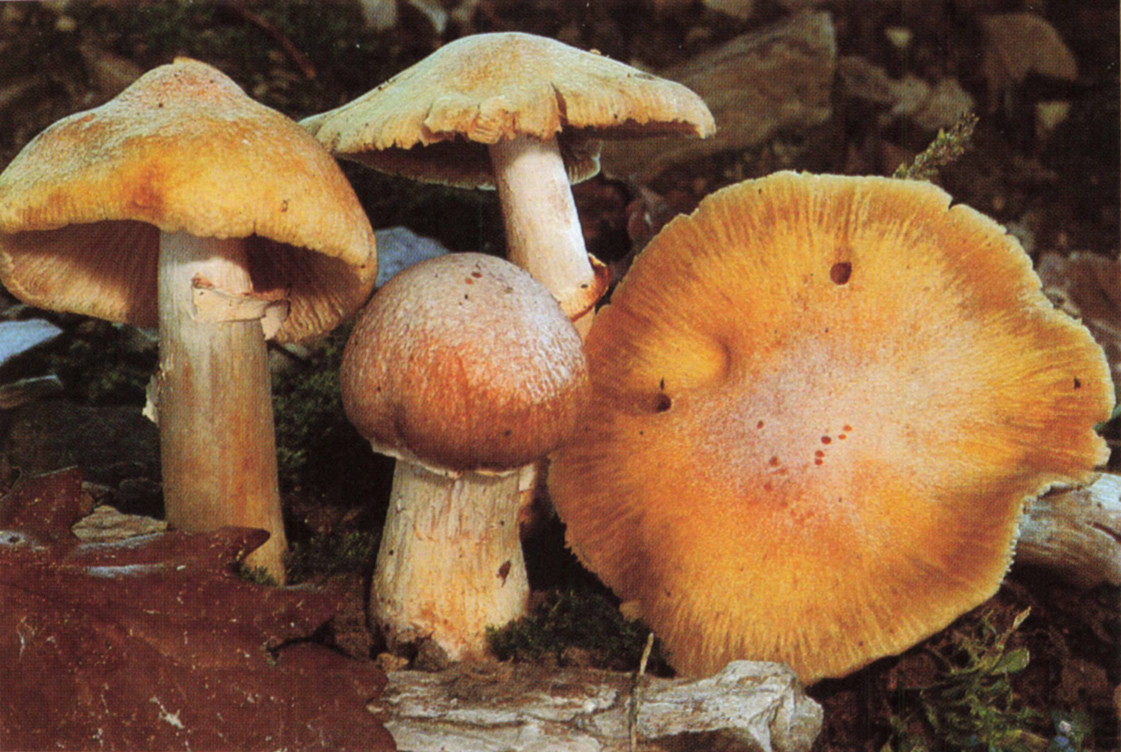
Key Features:
1. Medium-sized (cap 2–6″ broad, stalk at least ½″ thick).
2. Cap tan to golden-brown, usually wrinkled radially, not sticky or slimy.
3. Surface of cap without scales or hairs, but often overlaid with a thin white film when young.
4. Gills pale tan to brown.
5. Veil present, not cobwebby or hairy, at first covering the gills, then forming a distinct ring on stalk.
6. Spores brown or rusty-brown.
7. Growing on ground in forest or tundra.
Other Features: Cap at first domed, then becoming flat; flesh white; gills usually attached to stalk; volva absent.
Where: On ground near or under conifers, in birch forests, and in tundra with dwarf birch; widespread and common in northern latitudes, southward to northern California.
Edibility: Delicious, but be sure not to confuse it with Galerina, Agrocybe, and Cortinarius. In Europe and Japan it is commonly sold in farmer’s markets.
Note: The well-formed ring on the stalk, brown spores, and wrinkled cap are distinctive. So is the thin whitish film on the cap, when present. If you find a similar mushroom growing in wood chips, grass, or by a road, it is likely to be Agrocybe. See photo on this page; also see MD 412, 469–470, and plates 101–102.
Violet Cort (Cortinarius violaceus)

Key Features:
1. Cap and stalk deep purple.
2. Surface of cap roughened by many hairs or small scales, not sticky or slimy.
3. Gills deep purple when young, gradually becoming browner as they mature.
4. Stalk usually somewhat hairy or woolly, not sticky or slimy.
5. Veil present when young, purple, cobwebby (composed of fine fibers or hairs), soon disappearing or leaving a few hairs on stalk.
6. Spores rusty-brown.
Other Features: Medium-sized; flesh deep purple to grayish-purple; gills typically attached to stalk; stalk usually but not always thickened at base; volva absent.
Where: On ground or next to rotting logs in old coniferous forests and mixed woods; widespread but infrequent in northern latitudes, rare southward.
Edibility: Edible but hardly incredible; its principal appeal is its beauty.
Note: A memorable find! There are many other purple species of Cortinarius (the largest genus of mushrooms), but none as deeply colored as this one. The hairs or scales on the cap are also distinctive. See MD 417–419 and 446 for more information.
Northern Red-dye (Dermocybe sanguinea)
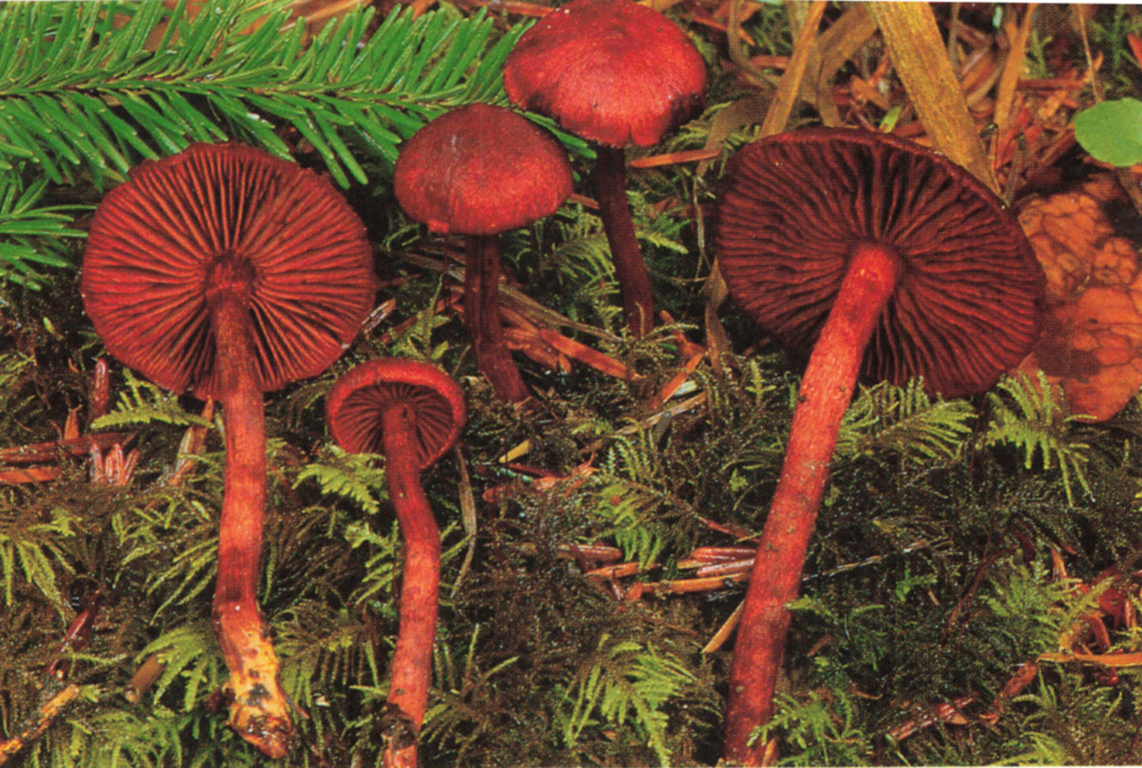
Other Names: Blood-red Cort, Cortinarius sanguineus.
Key Features:
1. Entire mushroom red to dark red when fresh (but gills becoming red-brown to rusty-brown when older).
2. Surface of cap not sticky or slimy and not changing color markedly as it loses moisture.
3. Stalk without a bulb at base.
4. Veil present when very young, cobwebby (composed of fine fibers or hairs), soon disappearing.
5. Spores rusty-brown.
Other Features: Fairly small; cap smooth or often with small scales; gills attached to stalk; stalk usually slender, of more or less equal width throughout, never sticky or slimy; veil reddish; volva absent.
Where: Scattered or in groups on ground under conifers (especially spruce); fairly common from Alaska to British Columbia, south to northern California but rare.
Edibility: Not recommended.
Note: Dyers and weavers esteem this beautiful little mushroom even more than they do its yellow-stemmed cousins, D. phoenicea and D. semisanguinea. It is sometimes confused with the California red-dye, D. californica, a red-orange species (see photo below) that gives less intense color. See MD 454–455 (as Cortinarius sanguineus) for more information.

The California red-dye, Dermocybe californica (=Cortinarius californicus), grows under conifers in California and the Pacific Northwest. It resembles the northern red-dye, but shows more orange in the stalk and gills. Also, its cap tends to fade as it loses moisture. The colors it gives are vivid, but not quite as intense as those of the northern red-dye.

Sweaters made from mushroom-dyed wool. The reds and oranges are derived from the northern red-dye, the blues and greens from a variety of mushrooms including the hawk wing (this page). The sweaters were made by the woman on the right, Christina Thunholm of Sweden.
Western Red-dye (Dermocybe phoenicea)
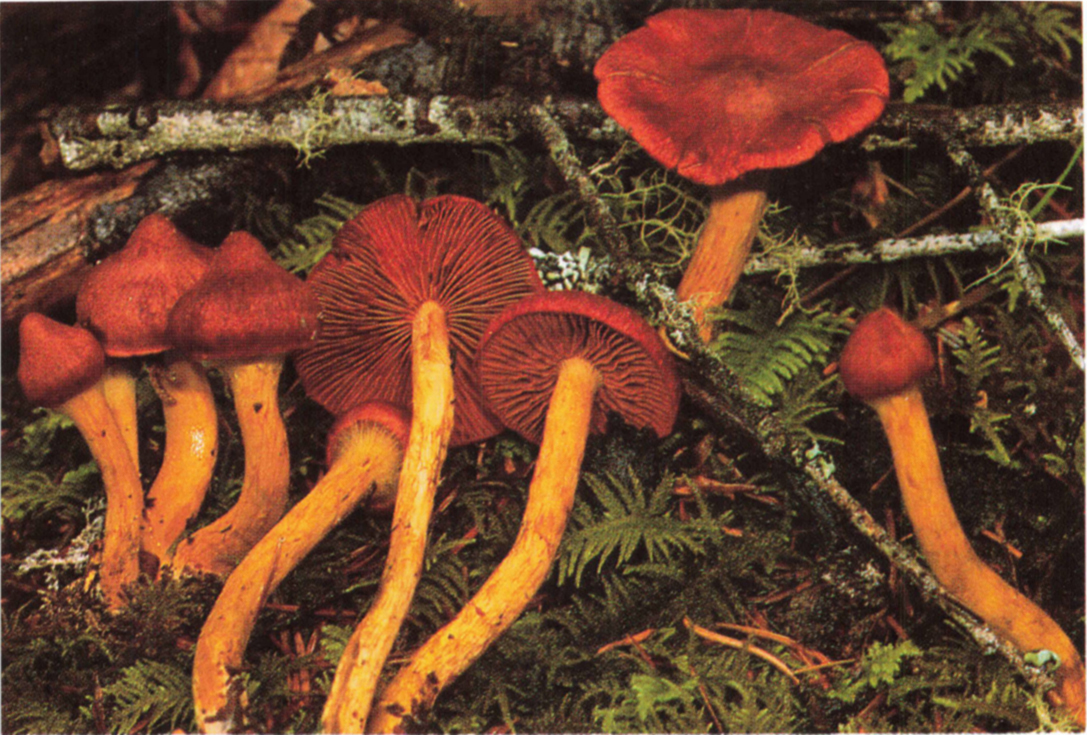
Other Names: Western Red-capped Cort, Cortinarius phoeniceus var. occidentalis.
Key Features:
1. Cap dark red to maroon or reddish-brown, not sticky or slimy.
2. Gills red to dark red (but becoming red-brown to rusty-brown in old age).
3. Stalk yellow or yellowish (sometimes tinged red or with reddish veil remnants, but never predominantly red).
4. Stalk without a bulb at base.
5. Veil present when very young, cobwebby (composed of fine fibers or hairs), soon disappearing.
6. Spores rusty-brown.
Other Features: Fairly small; cap not fading markedly as it loses moisture; gills attached to stalk; stalk usually slender, of more or less equal width throughout, not sticky or slimy; veil usually yellowish; volva absent.
Where: On ground in woods from the Pacific Northwest to central California. It is often abundant in pine forests with an understory of rhododendron or salal, but is difficult to see in such surroundings.
Edibility: Not recommended.
Note: This beautiful mushroom and its close relatives are prized by dyers and weavers for the beautiful shades of red, orange, rose, and purple they impart to wool. The dye pigment is chemically similar to cochineal. See MD 454 (as Cortinarius phoeniceus) for more information.
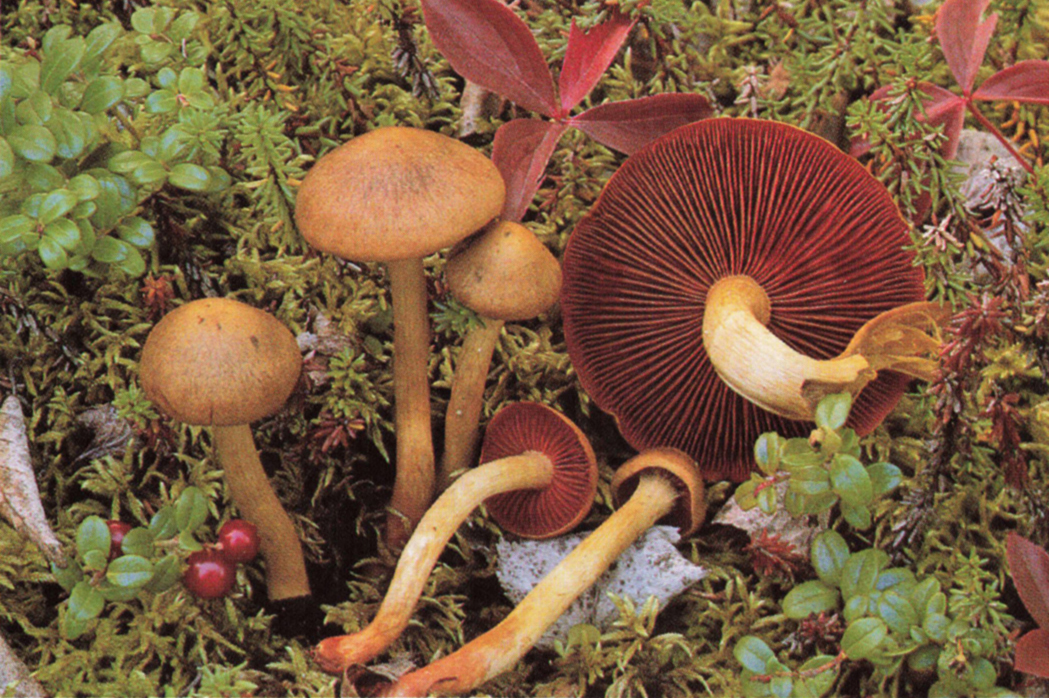
The eastern red-dye, Dermocybe semisanguinea (=Cortinarius semisanguineus), resembles the western red-dye but has a yellowish to yellow-brown or olive-brown cap. It is abundant in Alaska and adjacent Canada but infrequent elsewhere in western North America.
Fixin’ to Dye?
If wool, why not hair? Brigid Weiler of Cortes Island, British Columbia, dyed her hair pale rose (below) by using a few dried western red-dyes. The color lasted for two months, and would undoubtedly have been more vivid had she used more (and fresher) mushrooms. The dyer’s polypore, dead man’s foot, jack o’ lantern mushroom, and the tubes of the king bolete are also good candidates for hair-dyeing because they don’t require toxic mordants to give good colors.
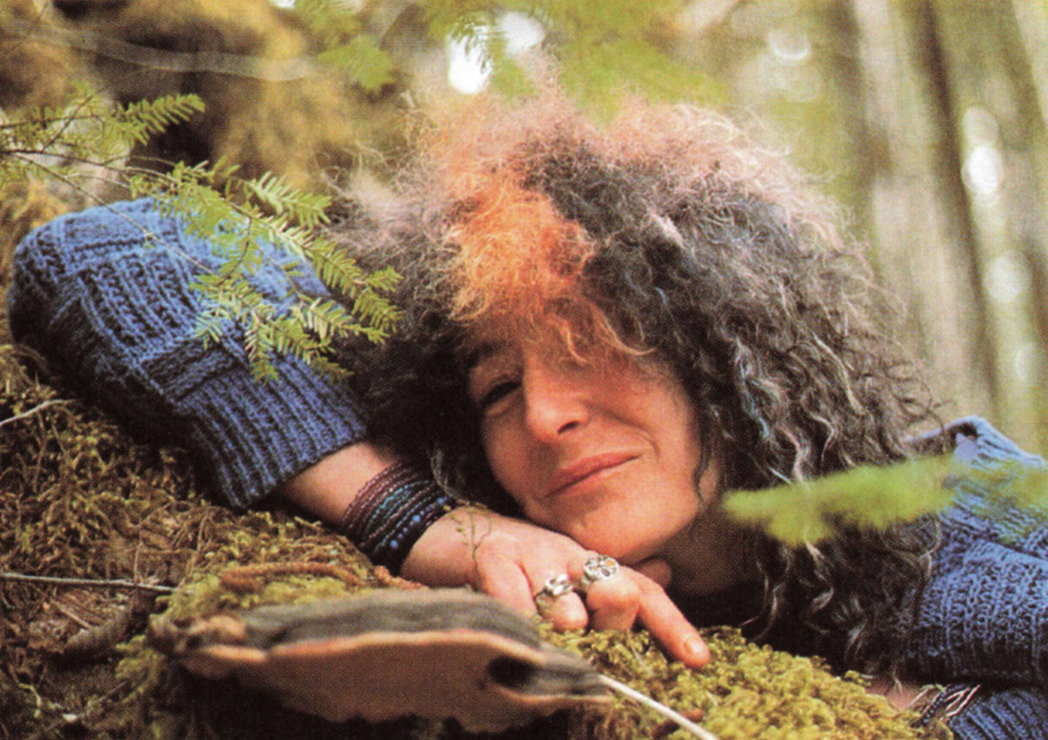
Poison Pie (Hebeloma crustuliniforme)
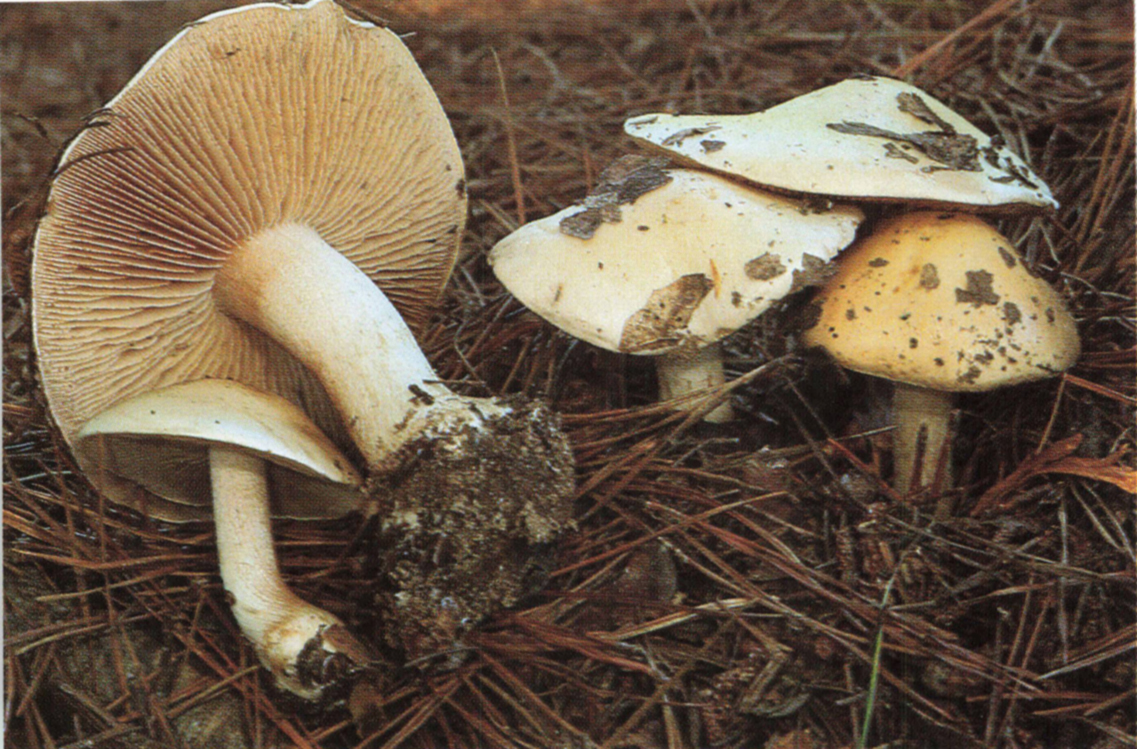
Key Features:
1. Cap tan to whitish, sticky or slimy when moist, bald (without fibers or hairs).
2. Gills pale tan to brown with white edges, attached to stalk and usually notched (dipping in) where they join it.
3. Stalk white, at least ¼″ thick, with small white dandruffy flakes or powder at top.
4. Veil, ring, and volva absent.
5. Odor of crushed flesh radishlike.
6. Spores brown.
Other Features: Medium-sized; cap domed at first, then flat or with a broad hump at center; edge of cap rolled under at first, not normally splitting in age; stalk thickest at base or with a small bulb; flesh white.
Where: On ground in woods and at their edges, and in tree-studded lawns and cemeteries, usually in groups or troops; widespread and common. Oak and pine are favored hosts.
Edibility: Poisonous, causing moderate to severe gastrointestinal distress.
Note: This ubiquitous, attractive mushroom is, unfortunately, not good to eat. The cap color is reminiscent of a pie crust, hence its popular name. There is no veil when young as in Cortinarius. See MD 464–465 for more information.
Inrolled Pax (Paxillus involutus)

Other Names: Poison Pax.
Key Features:
1. Cap brown, the edge rolled under when young.
2. Gills running down the stalk, pale when young, becoming yellowish with age and staining brown where bruised.
3. Gills and flesh not exuding a juice or milk when cut.
4. Stalk whitish to yellowish but staining brown when handled.
5. Veil, ring, and volva absent.
6. Spores brown.
7. Growing on ground.
Other Features: Medium-sized; mature cap flat or with a sunken center; gills often branched near the stalk to form large pores; stalk central to slightly off-center, not snapping open cleanly like a piece of chalk.
Where: On ground in woods and near planted birches; widespread and common.
Edibility: Not recommended. It is poisonous raw, and people who have eaten the cooked mushroom for years can suddenly develop a serious allergy resulting in kidney failure or even death.
Note: This mushroom is reminiscent of a milk cap (Lactarius), but the spores are brown and no milk or juice flows when the gills are cut. The tendency to stain brown is also distinctive. See MD 477–478 for more information.
Pine Spike (Chroogomphus rutilus & C. vinicolor)
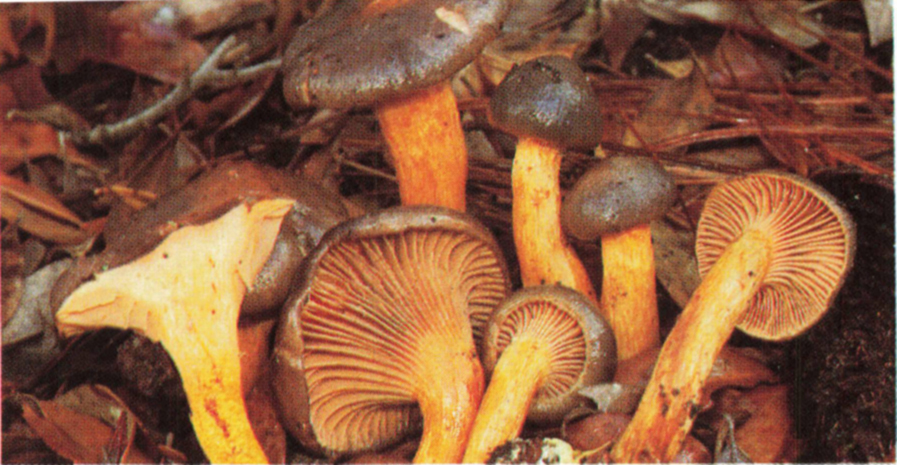
Key Features:
1. Cap bald and slightly sticky when moist, usually shiny in dry weather.
2. Gills widely spaced and running down the stalk, orangish when young, becoming gray or black with age.
3. Flesh pale orange in cap, pale orange or yellow in stalk (but sometimes reddish throughout when old).
4. Stalk solid (not hollow), without scales.
5. Spores dark gray to black.
6. Associated with pine.
Other Features: Medium-sized; cap domed or slightly pointed when young, broader or flatter in age, color variable: grayish to orangish, red-brown, wine-red, or burgundy; transient hairy or cobwebby veil present when young but rarely forming a ring; stalk often long and curved, color variable; volva absent.
Where: On ground near or under pines, often in groups or troops with slippery jacks (Suillus species); widespread and common, especially in coastal California.
Edibility: Mediocre; drying improves the flavor and texture.
Note: Pine spikes are easy to recognize as a group but difficult to distinguish from each other. The two species described here differ microscopically, and others also occur. See MD 484–487 and plate 113 for more information.
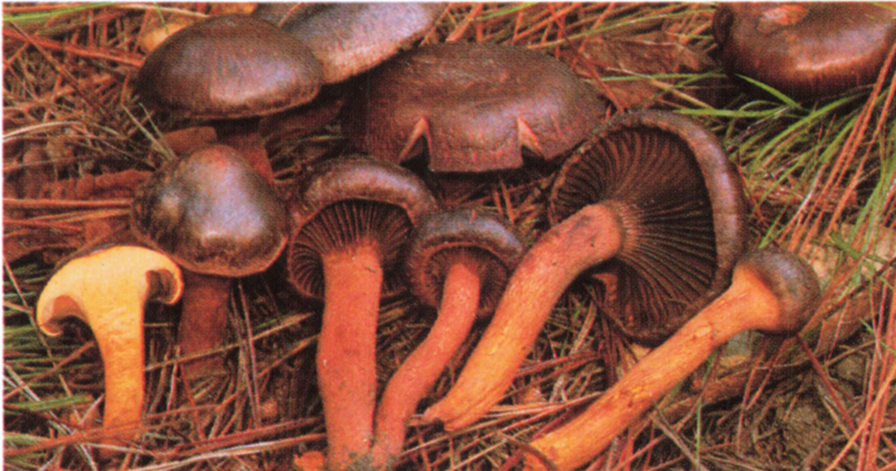
Woolly Pine Spike (Chroogomphus tomentosus)

Key Features:
1. Cap pale or dull orange to ochre.
2. Surface of cap dry to slightly sticky, with woolly hairs or fine scales.
3. Gills widely spaced, running down the stalk, yellow-orange to orangish when young, becoming gray to black with age.
4. Flesh pale orange in cap, pale orange or yellow in stalk.
5. Stalk solid (not hollow), without scales.
6. Spores dark gray to black.
Other Features: Medium-sized; cap at first rounded or pointed, broadening or flattening with age; transient hairy or cobwebby veil present when young, rarely forming a ring on stalk; stalk often curved, colored like cap; volva absent.
Where: On ground near or under northern conifers, often in groups or troops; very common in the Pacific Northwest, northern California, and the northern Rocky Mountains.
Edibility: Mediocre.
Note: The dry, hairy or woolly, orangish cap distinguishes this pine spike from its relatives. C. leptocystis is a similar species with a grayer cap. See MD 487 for more information.
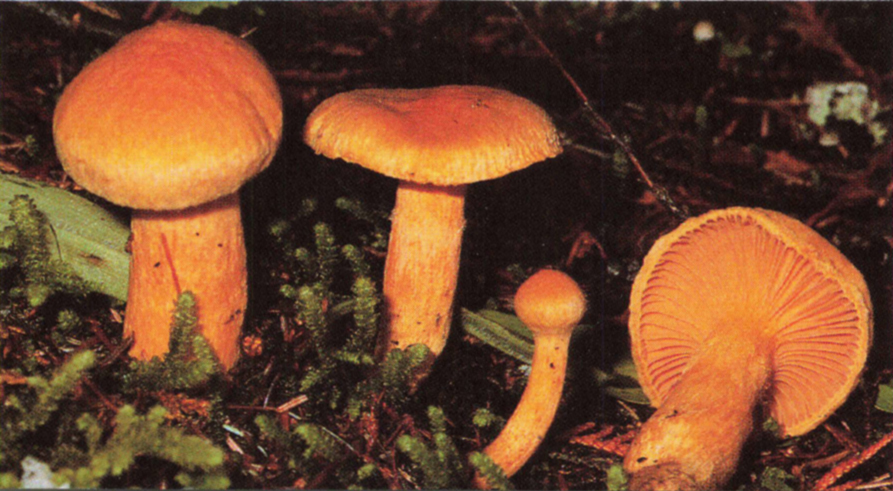
Hideous Gomphidius (Gomphidius glutinosus)
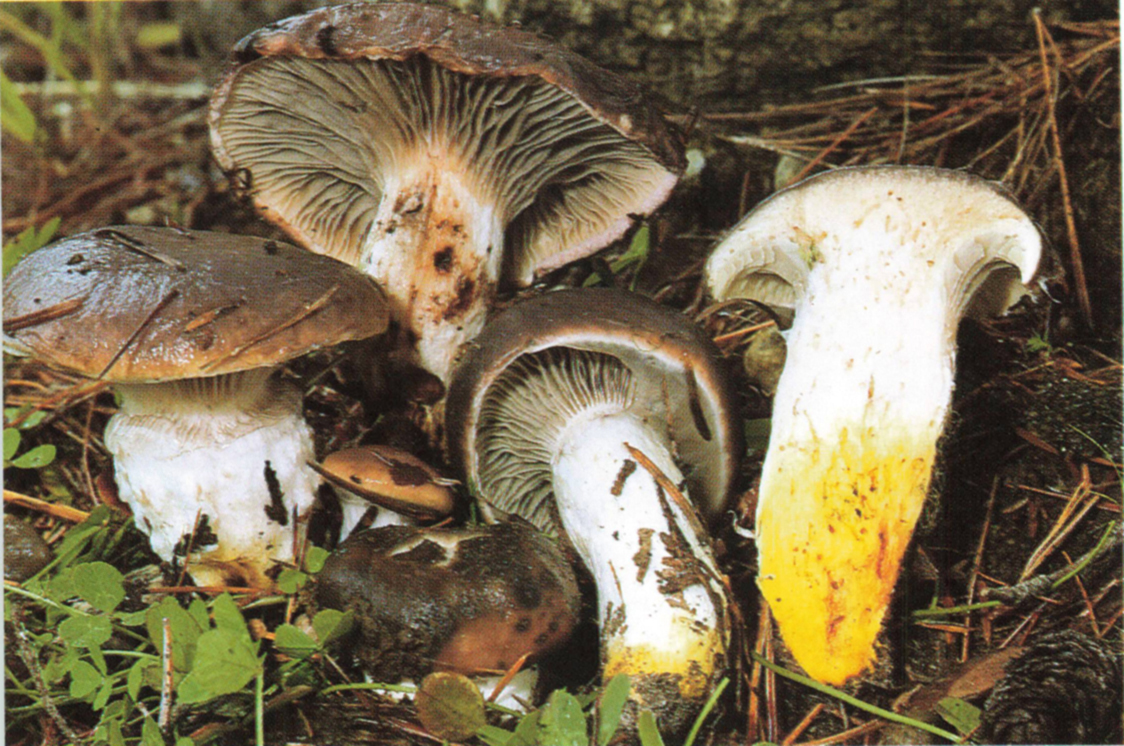
Other Names: Glutinous Gomphidius.
Key Features:
1. Cap dingy purple to purple-gray, reddish-brown, or sometimes brownish, often spotted or blotched with gray or black.
2. Surface of cap sticky or slimy when moist, bald.
3. Gills running down the stalk, white at first, then gray, and finally black.
4. Flesh white in cap and upper stalk, bright yellow in lower stalk.
5. Transient veil present, covering gills when young and sometimes forming an obscure ring on stalk.
6. Spores dark gray to black.
Other Features: Medium-sized; sticky skin peeling easily from cap; gills well spaced; volva absent.
Where: On ground near or under conifers (especially spruce, fir, hemlock); widespread, but most common in mountains.
Edibility: Edible; peel off the slimy skin before cooking.
Note: The slimy cap and brilliant yellow flesh in the base of the stalk are the hallmarks of this mushroom and its close relatives. G. maculatus is similar but lacks a veil and grows with larch. Two veiled species that favor Douglas-fir are shown below. See MD 481–483 and plate 112.
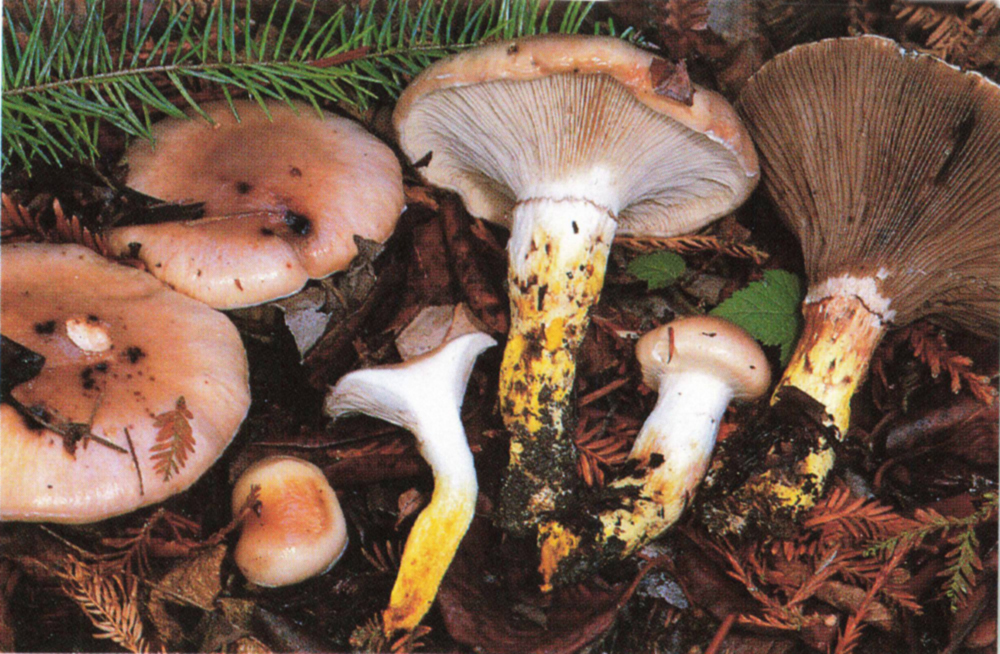
Gomphidius oregonensis differs microscopically from G. glutinosus and tends to have a slightly pinker or browner cap. It is common on the West Coast under Douglas fir, often in groups or clumps.
A Slick Adaptation?
The hideous gomphidius vies with the parrot mushroom, cowboy’s handkerchief, and various slippery jacks for the title of “slipperiest and slimiest fungus among us.” It is interesting to speculate on the function of the slime layer that coats the cap (and in some cases, the stalk) of these mushrooms, for it usually occurs on species with soft flesh. Perhaps it helps them to survive their humid environment. The slime may act like oil, repelling excess water and thereby ensuring that the crucial spore-bearing tissue (gills or sponge layer) matures before becoming waterlogged.
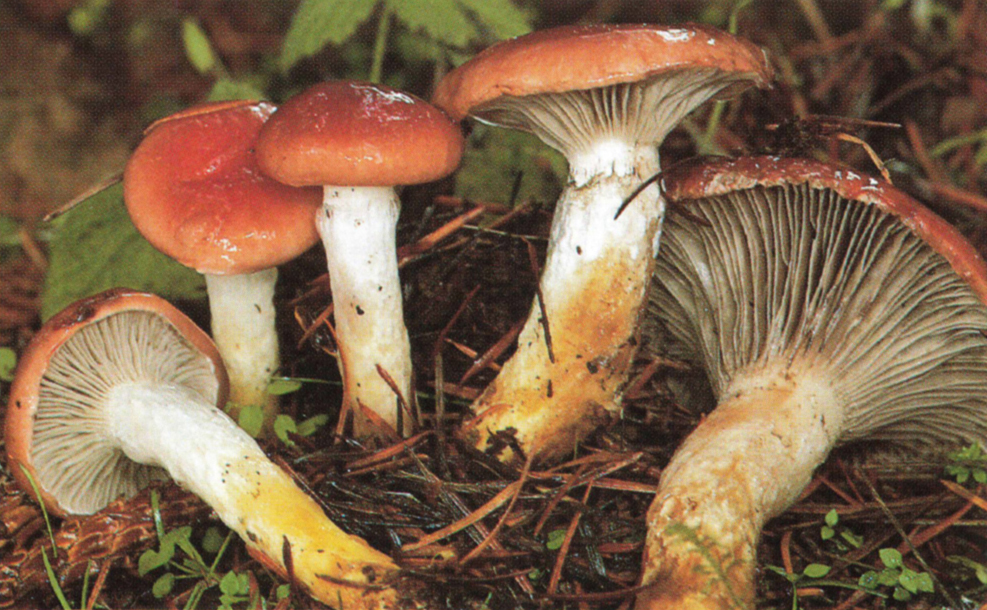
The rosy gomphidius (Gomphidius subroseus) is much more attractive than its brethren. It has a rosy cap, white to gray gills that run down the stem, a yellow stalk base, and dark gray to black spores. It is smaller than the hideous gomphidius and grows with Douglas-fir.